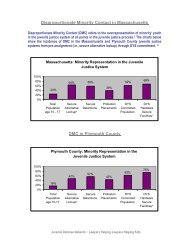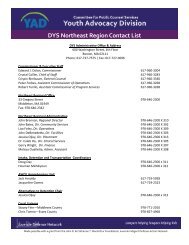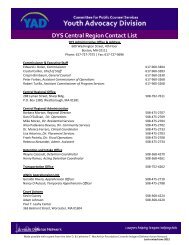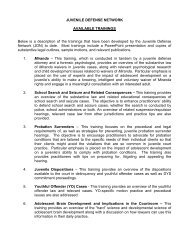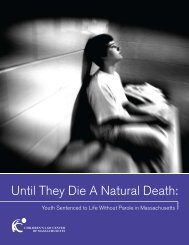States rethink 'adult time for adult crime' - the Youth Advocacy Division
States rethink 'adult time for adult crime' - the Youth Advocacy Division
States rethink 'adult time for adult crime' - the Youth Advocacy Division
Create successful ePaper yourself
Turn your PDF publications into a flip-book with our unique Google optimized e-Paper software.
Morse is not convinced that <strong>the</strong> Libet experiments reveal us to be helpless<br />
automatons. But he does think that <strong>the</strong> study of our decision-making powers<br />
could bear some fruit <strong>for</strong> <strong>the</strong> law. “I’m interested,” he says, “in people who suffer<br />
from drug addictions, psychopaths and people who have intermittent explosive<br />
disorder — that’s people who have no general rationality problem o<strong>the</strong>r than <strong>the</strong>y<br />
just go off.” In o<strong>the</strong>r words, Morse wants to identify <strong>the</strong> neural triggers that make<br />
people go postal. “Suppose we could show that <strong>the</strong> higher deliberative centers in<br />
<strong>the</strong> brain seem to be disabled in <strong>the</strong>se cases,” he says. “If <strong>the</strong>se are people who<br />
cannot control episodes of gross irrationality, we’ve learned something that might<br />
be relevant to <strong>the</strong> legal ascription of responsibility.” That doesn’t mean <strong>the</strong>y<br />
would be let off <strong>the</strong> hook, he emphasizes: “You could give people a prison<br />
sentence and an opportunity to get fixed.”<br />
IV. Putting <strong>the</strong> Unconscious on Trial If debates over criminal responsibility long<br />
predate <strong>the</strong> f.M.R.I., so do debates over <strong>the</strong> use of lie-detection technology.<br />
What’s new is <strong>the</strong> prospect that lie detectors in <strong>the</strong> courtroom will become much<br />
more accurate, and correspondingly more intrusive. There are, at <strong>the</strong> moment,<br />
two lie-detection technologies that rely on neuroimaging, although <strong>the</strong> value and<br />
accuracy of both are sharply contested. The first, developed by Lawrence Farwell<br />
in <strong>the</strong> 1980s, is known as “brain fingerprinting.” Subjects put on an electrodefilled<br />
helmet that measures a brain wave called p300, which, according to<br />
Farwell, changes its frequency when people recognize images, pictures, sights and<br />
smells. After showing a suspect pictures of familiar places and measuring his<br />
p300 activation patterns, government officials could, at least in <strong>the</strong>ory, show a<br />
suspect pictures of places he may or may not have seen be<strong>for</strong>e — a Qaeda training<br />
camp, <strong>for</strong> example, or a crime scene — and compare <strong>the</strong> activation patterns. (By<br />
detecting not only lies but also honest cases of <strong>for</strong>getfulness, <strong>the</strong> technology could<br />
expand our very idea of lie detection.)<br />
The second lie-detection technology uses f.M.R.I. machines to compare <strong>the</strong> brain<br />
activity of liars and truth tellers. It is based on a test called Guilty Knowledge,<br />
developed by Daniel Langleben at <strong>the</strong> University of Pennsylvania in 2001.<br />
Langleben gave subjects a playing card be<strong>for</strong>e <strong>the</strong>y entered <strong>the</strong> magnet and told<br />
<strong>the</strong>m to answer no to a series of questions, including whe<strong>the</strong>r <strong>the</strong>y had <strong>the</strong> card in<br />
question. Langleben and his colleagues found that certain areas of <strong>the</strong> brain<br />
lighted up when people lied.





